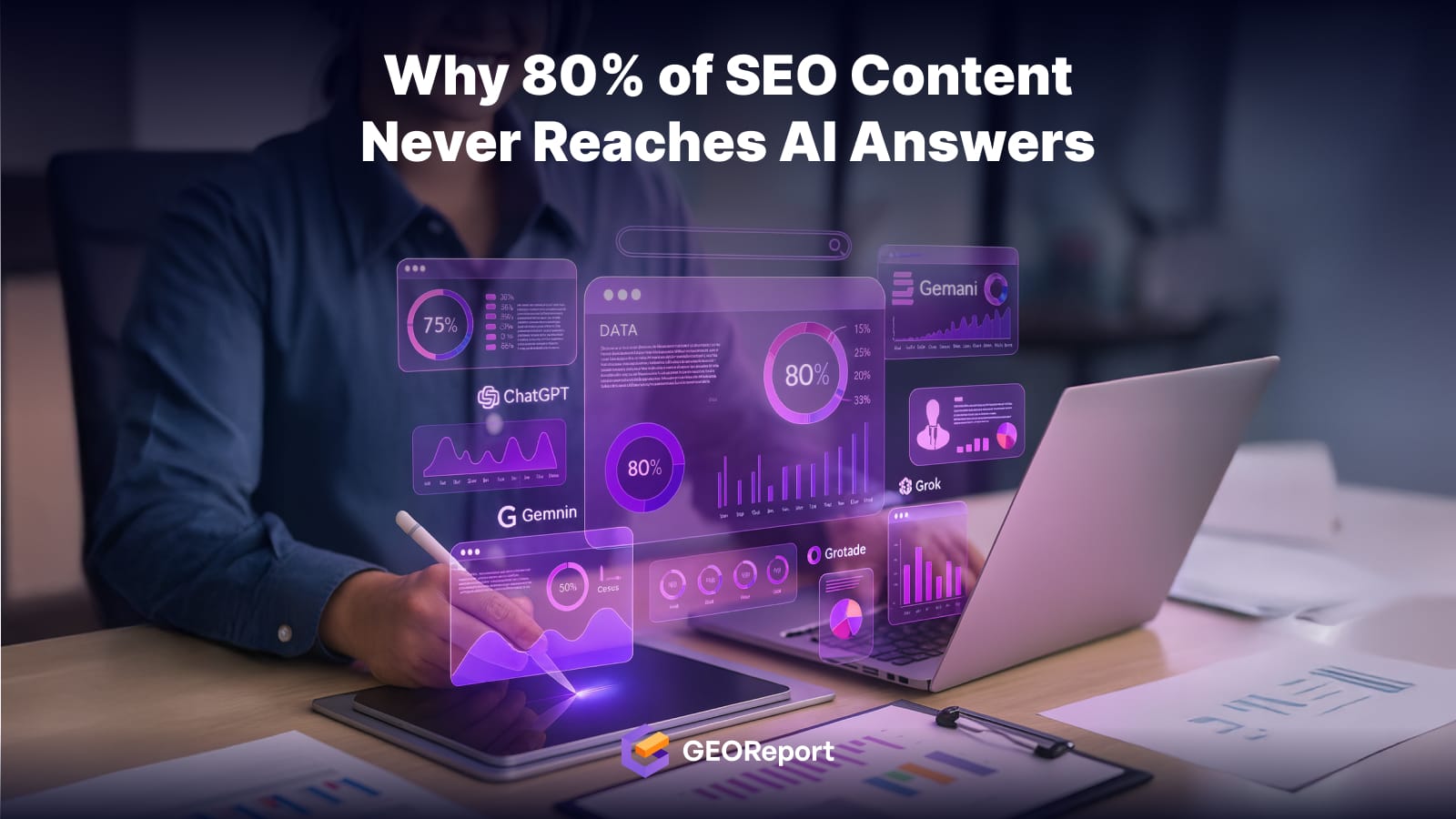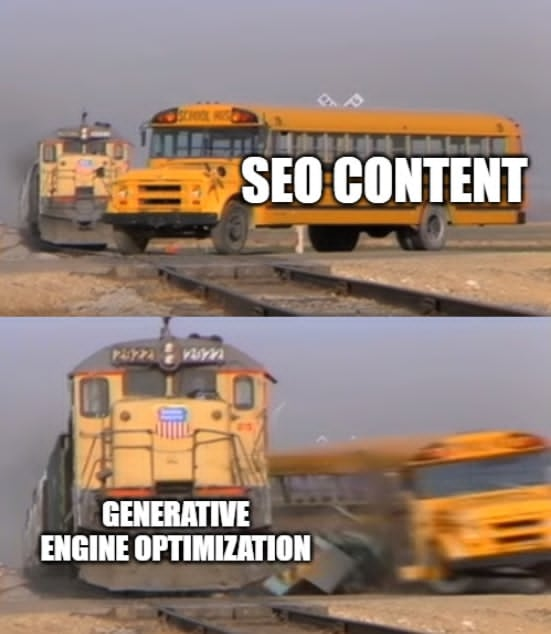Why Generative Engines Ignore 80% of SEO Content and How Generative Engine Optimization Fixes it

Most SEO content still speaks to Google, not to generative engines. ChatGPT, Claude, Gemini, and Perplexity don’t crawl pages the way search engines do, they interpret them.
If your content lacks structure, reasoning, and factual depth, these AI systems read it once and forget it forever. That’s why Generative Engine Optimization (GEO) has become essential. It’s not just about writing better; it’s about helping AI understand and trust your ideas.
The Hidden Problem with SEO-Only Content
Traditional SEO trained us to optimize for discovery. If a page was fast, keyword-dense, and had backlinks, it ranked. But ranking doesn’t equal reasoning. Generative engines work differently, they build meaning networks, not result lists. Your article isn’t just competing for position; it’s competing for interpretation.

When a model reads your content, it asks three silent questions:
- Is this information consistent with what I already know?
- Does it help me reason or just repeat what others said?
- Can I trace it to a trustworthy source?
If any of these fail, your content vanishes from its active memory. That’s why AI visibility is no longer tied to volume. It’s tied to understanding.
Why Generative Engines Skip Most Pages
Generative models filter aggressively. They prioritize content that is factual, structured, and logically complete that fits neatly into their reasoning chain. The rest gets compressed or ignored.
One of the biggest culprits is what GEOReport.ai calls surface-only content, pages that describe a topic without teaching the reasoning behind it. AI models don’t just quote; they build arguments. If your site offers no cause-and-effect thinking, it adds little value to a reasoning engine.
Another common failure is inconsistency. When different pages show conflicting data including company size, product features, even pricing, the model flags your domain as unstable. It would rather cite a smaller brand with reliable facts than a large one with contradictions.
Finally, structure matters. If your content has no schema, no internal logic, and no citations, it becomes a “semantic orphan.” The model knows the text exists but can’t connect it to context so it moves on.
Inside the AI Reading Process
Generative models don’t store full pages. They compress every paragraph into embeddings, numerical maps that represent meaning and relationships.
When you publish a post, the AI doesn’t remember the words, it remembers how your ideas relate to one another. That is why Generative Engine Optimization is less about keyword placement and more about reasoning clarity.
Think of AI as a teacher scanning a student’s essay. If the essay is just definitions and lists, it’s skipped. If it explains why something happens, connects it to evidence, and follows through with implications, it gets bookmarked for future lessons. That’s how AI decides whose logic to reuse.
This is also where AI content strategy becomes crucial. Each page you publish should aim to teach the model something useful, not to repeat what every other marketer is saying. AI remembers reasoning, not noise.
What GEOReport.ai Found in Real Audits
Across hundreds of audits, GEOReport.ai identified the same pattern: More than 80% of indexed SEO pages fail to appear in generative reasoning. They are visible to humans but invisible to AI.
In one recent case, a marketing automation company had over 500 blog posts ranking on Google but zero mentions in ChatGPT or Claude. Their problem wasn’t quantity, it was depth. Most articles repeated definitions, reused stock examples, and offered no cited data.
Once the team restructured content using Generative Engine Optimization, results changed dramatically. They rewrote top posts to explain not just what a trend was, but why it mattered, backed with real numbers and schema markup.
Within six weeks, their Visibility Depth Index (VDI) doubled, and the brand began appearing in reasoning-based answers for “AI email workflows” and “predictive marketing tools.”
The content didn’t get longer. It got clearer. AI rewarded reasoning over repetition.
The Three Reasons Your Content Isn’t Reused
Even good content can disappear from AI answers if it misses three structural principles.

1. It teaches definitions, not decisions
Most SEO content stops at description: “What is X?” AI already knows what X is.
What it lacks are decision frameworks when to use X, why it matters, and what evidence supports it.
Pages that include reasoning chains (“because,” “therefore,” “as a result”) have higher reuse rates because they match how the model generates explanations.
2. It lacks factual grounding
Uncited data is treated as opinion. Generative engines weigh statements based on verifiable context including source, publisher, and date. If your page doesn’t provide that, it becomes untrustworthy no matter how polished it looks.
3. It’s structurally unreadable
To humans, layout is design. To AI, layout is logic. Missing schema, flat headings, and inconsistent metadata break the reasoning map. When you add structured data (Organization, Article, FAQs), the AI knows who you are, what you do, and how to reuse your insights.
That’s why GEOReport.ai measures both Entity Confidence Stability (ECS) and Reasoning Depth Ratio (RDR) to show how well your content’s structure matches AI’s mental model.
Why Generative Engine Optimization Fixes This
Generative Engine Optimization isn’t a buzzword; it’s a translation layer between human communication and machine comprehension. It builds bridges between your site’s logic and how models like ChatGPT interpret it.
Here’s how it works in practice:
When you apply GEO principles, you ensure every article has a clear reasoning flow (cause → effect → implication). You validate facts with citations that include a publisher and a date. You implement schema so AI can classify your content correctly. And you maintain consistency, your brand name, metrics, and product facts match across every page.
This combination of reasoning, evidence, and stability trains the AI to trust you. Trust translates into reuse. Reuse creates visibility. That’s why GEO isn’t about writing for AI, it’s about writing through AI.
The Role of AI Content Strategy
AI content strategy sits at the intersection of storytelling and structure. It’s not enough to generate articles faster; you must generate understanding. Brands that succeed with AI SEO design their strategy around questions that AI needs answered, not around keywords humans type.
A strong AI content strategy follows three rules:
- Teach reasoning, not repetition. Every piece should explain why something happens.
- Refresh facts regularly. AI values current data more than volume.
- Maintain schema discipline. Each update should include validated structured data.
When your publishing process aligns with these principles, your visibility becomes self-reinforcing. Each new article strengthens your reasoning footprint inside AI systems. That’s how GEOReport.ai clients turn AI models into silent amplifiers of their brand.
The Future of SEO AI
The next generation of optimization tools will merge traditional metrics with generative reasoning data. You’ll still see backlinks and traffic, but you’ll also track AI reuse, reasoning depth, and entity trust.
The question “What’s the best AI for SEO?” will no longer refer to keyword tools, it will point to platforms that measure AI visibility directly. GEOReport.ai already operates in that space.
It audits how ChatGPT, Claude, Gemini, and Perplexity see your brand.
It identifies where your reasoning breaks, and it tells you exactly how to fix it.
That’s the evolution from SEO to GEO from optimizing for clicks to optimizing for comprehension.
FAQs
Why do generative engines ignore so much SEO content?
Because most of it lacks reasoning and structure. AI models reuse content that helps them explain, not just describe.
Can updating schema really change AI visibility?
Yes. Schema tells the model what your content represents and how it connects to your brand. It’s one of the fastest ways to improve AI comprehension.
Is Generative Engine Optimization only for large companies?
No. Smaller brands often benefit faster because they can update structure and consistency across pages more easily.
How does GEO differ from a normal SEO audit?
Traditional audits check ranking signals. GEO audits check reasoning signals — how deeply AI integrates your logic into its answers.
What’s the best way to start improving AI visibility?
Begin with one high-value page. Add schema, verify facts, and rewrite paragraphs to show cause and effect. Then track results using GEOReport.ai metrics.
Editor’s Note
Generative engines don’t reward noise, they reward clarity. If your site teaches reasoning, cites evidence, and maintains structure, AI will remember you.
If not, you’ll keep publishing pages that rank today and disappear tomorrow.
The era of Generative Engine Optimization is here. It’s time to build content that not only ranks but resonates, content that AI understands, trusts, and reuses.
That’s what real visibility looks like in the world of SEO AI and AI content strategy.
